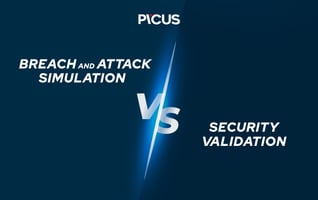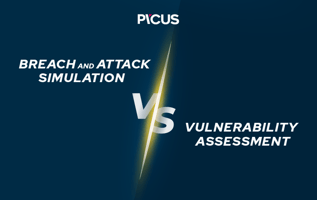In cybersecurity, Breach and Attack Simulation (BAS) is an automated, continuous software-based approach that offensively validates organizational exposures—such as misconfigured security controls, software vulnerabilities, and weak security baselines—in a safe and non-destructive manner.
Similar to other adversarial exposure validation tools, like automated penetration testing and red teaming, BAS tests enhance exposure management programs by reducing the number of exposures that need attention. This enables security teams to effectively prioritize the most critical risks. By factoring in the effectiveness of implemented compensating controls, BAS tools reveal the true business impact of cyber risks, streamlining remediation efforts and reducing the operational burden on security teams.
What Is the Objective of BAS Simulations?
The objective of BAS tools is to deliver the most realistic exposure validation experience, and here is why: these solutions work by mimicking the tactics, techniques, and procedures used by real cybercriminals to validate identified exposures in the presence of an organization’s defensive measures (making no exceptions whatsoever). What does this mean? It means that BAS tools assess whether an exposure can actually be exploited by an adversary. In other words, BAS technologies provide data-driven insights into the feasibility of an exposure being exploited within an organization’s unique environment.
Thus, the reliability of the data output by BAS lies in its consideration of the effectiveness of an organization’s security measures. Let us explain this with a solid example.
Assume that your exposure assessment platform outputs a software vulnerability, say CVE-2024-38063, with a high CVSS score of 9.8 (critical). However, despite this possibly devastating score, the conditions necessary for a successful attack may not be present, or the NGFW implemented by the security team may block the attack at its initial stage. Consequently, the exposure doesn’t present as critical a risk as it might appear on paper (a.k.a theoretical, refer to Figure 1 below).

Figure 1. BAS Demonstrating the Actual Risk Potential of an Exposure
Therefore, BAS solutions validate the actual risk an exposure poses to business operations, helping security teams allocate remediation resources realistically to address the risks that truly matter.
Attack Vectors Run by BAS Solutions
An effective BAS solution with a high return on investment (ROI) should offer a diverse range of attack vectors, enabling organizations to emulate and simulate advanced adversarial behaviors observed in the wild, providing the most comprehensive and realistic adversarial exposure validation experience.
Expected attack vectors run by a BAS assessment include, but are not limited to:
-
Malware and ransomware download attacks
-
Atomic attacks (e.g., credential dumping scenarios)
-
Attack scenarios for APTs and threat groups
-
Data exfiltration attacks
-
Web application and email infiltration attacks
-
Vulnerability exploitation attacks
These attack vectors are expected to be continuously updated by analyzing commonly used attack patterns, emerging threat alerts, and active threat groups or malware campaigns that may target specific regions or sectors.
In addition, to enhance user convenience and deliver a smoother experience, BAS vendors can offer ready-to-run attack templates. These templates can be curated to include, for example, all emerging threats from the past year or highly impactful threats associated with recent exploitation activities, such as attacks by threat actors exploiting CVEs listed in CISA’s Known Exploited Vulnerabilities (KEV) catalog.

Figure 2. BAS Solutions Provide Ready-to-Run Attack Templates
In addition, by regularly encouraging users to simulate attacks from publicized and active threat groups, BAS creates an environment for continuous, proactive exposure validation. For example, by running simulations that mimic the advanced attack techniques of a specific threat group, such as Midnight Blizzard, organizations can validate exposures that might be exploited in a potential kill chain, examining them in a structured, chained manner.

Figure 3. BAS Platforms Push Continuous and Proactive Improvement of Security Posture
Which Security Controls Are Tested with BAS?
BAS solutions play a crucial role in the exposure management lifecycle because they continuously and automatically validate cyber risks while factoring in the effectiveness of the organization’s implemented security controls.
These platforms test and validate the performance of security controls, including but not limited to:
-
Next-Generation Firewalls (NGFW)
-
Intrusion Detection Systems (IDS)
-
Intrusion Prevention Systems (IPS)
-
Anti-virus and Anti-malware Software
-
Endpoint Detection and Response (EDR)
-
Extended Detection and Response (XDR)
-
Data Leakage Prevention (DLP)
-
Security Information and Event Management (SIEM) solutions
-
Email Gateways
By simulating real-world attack scenarios, BAS platforms evaluate these controls' capabilities in detecting, preventing, and mitigating threats. They collect data on the progression of simulated attacks, offering insights into potential risks and identifying gaps in the organization's security posture.
Why Is Breach and Attack Simulation Important?
BAS is an important adversarial exposure validation tool that enables organizations to proactively assess their security posture and identify exposures before they can be exploited by cybercriminals. By simulating real-world attack scenarios, BAS provides valuable insights into the effectiveness of security controls and highlights areas for improvement.
In the context of exposure management, BAS solutions enable organizations to:
-
Prioritize the most critical exposures within the unique context of the organization’s IT environment
-
Streamline remediation efforts by filtering out exposures that do not present any real risk (refer to Figure 1).
-
Minimize the likelihood of successful cyberattacks by staying ahead of sophisticated adversary behaviors
As the cyber threat landscape continues to evolve, BAS has become a crucial component of a comprehensive cybersecurity strategy, ensuring that organizations maintain a robust defense against potential breaches.
The Top Three Benefits of an Automated Breach and Attack Simulation Tool
There are three main benefits of a BAS solution.
Continuous Validation of Cyber Risk Factoring Security Control Effectiveness
BAS solutions offer substantial advantages over traditional security practices such as manual penetration testing and red teaming. Traditional methods, while effective, are often constrained by the need for skilled professionals, limited scope, resource demands, and variability in outcomes. Additionally, they are typically conducted only once or twice a year due to high costs and potential disruption to organizational networks and resources. This limited frequency prevents them from effectively validating newly emerging exposures between engagements.
As attack surfaces continue to expand and become increasingly dynamic, the continuous assessments provided by BAS solutions are essential. BAS delivers automated, ongoing stress testing on an organization’s security controls against the latest and most sophisticated adversarial behaviors, offering a more adaptive and resilient approach to managing today’s complex security landscape.

Figure 4. Overall Prevention and Detection Results of an Arbitrary Host from the Picus Security Validation Platform.
Better Mobilization of Remediation Efforts with BAS
One of the benefits of BAS tools, as highlighted earlier, is their ability to reduce the sheer number of exposures, filtering them into a manageable set for the security team to address. Although Exposure Assessment Platforms (EAPs) can identify hundreds or even thousands of exposures, it is impractical for any security team, regardless of size, to tackle every single issue. Additionally, being required to address each identified exposure can significantly disrupt business operations, as patching and remediation efforts take time and can put operations on hold.
To address this, BAS solutions validate identified exposures to determine which ones are feasible for an adversary to exploit within an organization’s IT environment. This approach effectively bridges the prioritization gap left by legacy scoring systems like CVSS and EPSS. While these systems are useful for indicating the maximum potential impact of, for example, a CVE, adversarial exposure validation tools like BAS reveal the true impact of a specific exposure within the organization.

Figure 5. BAS Solutions Working as a Filter for Organizational Exposures
In other words, BAS helps security teams understand whether an attempted attack leveraging a particular CVE can be blocked immediately, partially, or, if not, at least logged and alerted as expected. This technique assesses the effectiveness of existing security defenses, sparing the team from addressing theoretical risks with no practical threat to the organization.
As a result, BAS provides a smaller, prioritized subset of exposures for remediation, enabling more efficient resource allocation.
Actionable Results and Mitigation Suggestion for Smooth Remediation
One of the most critical benefits of BAS solutions is the actionable, ready-to-apply mitigation suggestions they offer. BAS tools excel not only in validating which exposures need remediation but also in delivering mitigation recommendations that are researched and tailored for a variety of security control vendors.

Figure 6. Ready-to-Apply Mitigation Suggestions from Picus Security Validation
This is essential because, in many cases, remediating vulnerabilities can take several days or weeks and may disrupt business operations. To address this challenge, BAS tools provide immediate mitigation suggestions that can be applied to security controls, giving security teams valuable time to fully remediate the exposure while minimizing disruptions.
Is It Possible for Breach and Attack Simulation Testing to Cause Damage to an Organization’s Systems or Data?
BAS testing is designed to be safe and non-intrusive, allowing organizations to evaluate their security posture without compromising sensitive data or disrupting daily operations. These simulations are conducted in controlled environments, minimizing unintended consequences on other systems.
BAS solutions comply with regulatory frameworks and offer customizable testing parameters, enabling security professionals to tailor simulations to their specific environments and risk tolerance. Importantly, BAS does not require intrusive network scanning or firewall exceptions, ensuring that existing security infrastructures remain intact during testing. This approach provides a reliable and secure method for assessing and validating an organization's security controls.
What to Consider When Choosing a Breach and Attack Simulation?
When evaluating a BAS solution, you need to consider the following criteria.
Up-to-date Against Current and Emerging Threats:
An effective BAS solution must remain updated to address both current and emerging threats. As the cyber threat landscape continually evolves, the threat library in BAS should be consistently refreshed to keep pace with new techniques, vulnerabilities, and attack campaigns.
Threat Simulation Across the Full Attack Lifecycle:
An effective BAS solution should simulate a range of cyber threat techniques spanning the entire attack lifecycle. This includes:
-
Pre-Compromise Attacks: Email-based threats, malware downloads, vulnerability exploitations, and web application attacks.
-
Post-Compromise Attacks: Endpoint-specific attacks, data exfiltration, and lateral movement within the network.
-
Attack Campaigns: Scenarios based on malware tactics and campaigns led by known threat groups.
This approach enables a deeper understanding of potential adversary actions at each attack stage.
Pricing in Choosing the Right BAS Vendor
When evaluating BAS solutions, pricing varies significantly among vendors, influenced by factors such as features, deployment models, and organizational needs. For instance, some vendors offer comprehensive packages that reflect their extensive capabilities, while others provide more accessible entry points, making them cost-effective options for organizations seeking robust BAS functionalities. Therefore, organizations should assess their specific requirements and budget constraints to select a BAS solution that offers the best value for their investment.
Validation of Enterprise Security Controls:
Organizations deploy a wide range of security controls across diverse networks and locations. A robust BAS solution should thoroughly evaluate the entire security infrastructure and integrate smoothly with various prevention and detection technologies.
Continuous and Automated Simulation:
BAS delivers ongoing, automated attack simulations to efficiently identify misconfigurations in security controls and monitor configuration changes. This process operates without manual intervention, consistently assessing the status of various security controls.
Threat Customization:
Every organization faces a unique cyber threat landscape, necessitating tailored threat prioritization. BAS should provide threat profiling to assist SOC teams in identifying and prioritizing relevant risks. Additionally, it should allow custom attack simulations and campaigns, enabling security teams to simulate their specific threat landscape and accurately assess their security posture.
Direct and Actionable Mitigation Insights:
Threat simulations reveal gaps in security controls, and a BAS solution should provide actionable mitigation guidance for these gaps, including emerging threats and zero-day vulnerabilities (when a public PoC is available). This empowers SOC teams to quickly craft tailored mitigation strategies.
Real-Time and Customized Reporting:
BAS solutions should generate assessment reports suitable for various stakeholders, including executives, SOC teams, and auditors. These reports should present real-time metrics, such as overall security score, detection rate, log collection, detection, and prevention.
Mapping to MITRE ATT&CK and Other Frameworks
A robust BAS solution should support industry frameworks like MITRE ATT&CK, mapping threat simulations to standardized methodologies. This alignment helps organizations identify security gaps, benchmark against industry best practices, and prioritize remediation based on the most relevant threats.
Ease of Use and Ease of Deployment
A BAS solution should be easy to deploy and use to ensure seamless integration with an organization's existing security infrastructure. The solution should have a user-friendly interface and provide clear instructions for deployment, configuration, and maintenance. Additionally, it should offer flexible deployment options, such as on-premises, cloud-based, or hybrid, to accommodate different organizational needs and network architectures. An easy-to-use and easy-to-deploy solution will encourage adoption and help organizations maximize the benefits of a BAS solution.
Picus Automated Breach and Attack Simulation (BAS) Platform
At Picus, we offer a cutting-edge Breach and Attack Simulation (BAS) solution designed to continuously assess and strengthen an organization's security posture. Leveraging our pioneering BAS technology, our Security Control Validation (SCV) module both simulates and emulates real-world cyber threats to evaluate the effectiveness of security controls, identify vulnerabilities, and provide both vendor neutral and specific actionable mitigation insights.
This proactive approach ensures that defenses remain robust and adaptable to evolving threats. Integrated with frameworks like MITRE ATT&CK, the platform delivers comprehensive threat coverage, while its intuitive interface and detailed reporting streamline the security validation process, making it both efficient and accessible.
What Does Gartner Say About Picus Security?
Gartner has recognized Picus Security as a 2024 Customers' Choice in the Breach and Attack Simulation Tools category. This prestigious distinction highlights Picus's dedication to delivering innovative and high-quality BAS solutions, tailored to meet the needs of organizations aiming to enhance their cybersecurity resilience.
Read all Gartner reviews about Picus Security's Breach and Attack Simulation solutions.
-1.png?width=242&height=177&name=image%20(1)-1.png)








